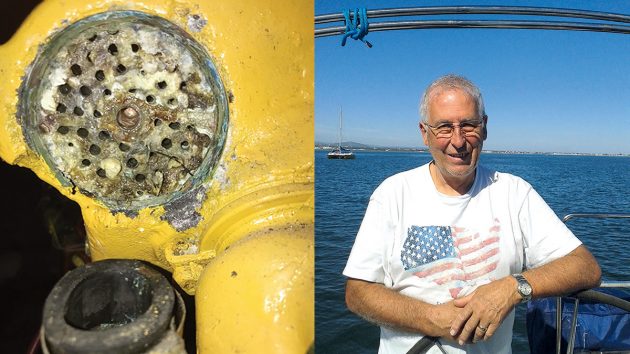PBO reader Alan Carter has a question about cleaning rusty engine innards. Engine whisperer Stu Davies has this advice...
Alan Carter from Dunfermline writes: “I’m on the way to solving the problem of rusty innards in my old boat engine – something that afflicts the engines of many practical boat owners. My first step was to remove the exhaust manifold/heat exchanger – four easy bolts.
“This came away with the water inlet pipe, and I discovered all water passages and pipes were blocked with magnetite-type corrosion products. I ran a drill gently through all of the water passages and into their partners in the head and tested that I had a water flow in and out.
“Rydlime did not really do much to remove any more of this black corrosion, even though I soaked the manifold for a couple of days. Around this time I was given a second rusty old engine to play with – same blockages as the other – but this time I soaked the manifold in household central heating corrosion remover.
Note: We may earn a commission when you buy through links on our site, at no extra cost to you. This doesn’t affect our editorial independence.
Article continues below…
No mess oil filter change for a boat engine
Simon Westmacott devises a way to keep his bilges clean when changing the engine's oil filter
Cleaning a diesel tank: a practical guide
Richard Barnard braves the mess and overcomes key challenges for the satisfaction of a clean fuel tank, free from sediment…
“This did a lovely job of cleaning the passages, so I then followed that up with the appropriate inhibitor to neutralise the product. I removed the core plugs to see whether they had been affected by the harsh corrosion remover, but their plating looked fine.
“When the boat is next out of the water we’re going to pop some of this central heating cleaner in a bucket and pump it round the engine, going down through the water outlet hose connector and out through the water pump minus impeller and thermostat.
“We’ll do this for a few hours and then pump round inhibitor for the same time using a cheap 12V pump. It’s worth a bash but the engine is old and we must soon consider its replacement.
“My main question, however, is that the engine has always been a pig to start – that is until we tried repositioning the inlet air filter, adding a gauze insert into the long air tube and heating its long arm with a blow lamp. That seems to work a treat! Do you have any other starting tips you can give me?”
PBO engine expert Stu Davies replies: “Excellent PBOing – this is what our world is about! You’ve done an excellent job and a lot of thought has gone into it. The back flushing idea from the exhaust elbow connection is particularly good.
“It gets the cleaning solution through the engine yet avoids getting it into the exhaust system and cylinders of the engine. The difficulty of starting the engine? Old age and general wear are a combination that perhaps gives lower compression and therefore difficult starting.
“You’ve had the valves re-ground and that addresses what could have been one of the causes. The idea of heating the intake is again a good idea for the first start – a system that was the default back in the day with Perkins fitting a dribble heating coil to do the same thing.”
Got a question? Email pbo@futurenet.com and we’ll put it to our panel of experts.
Why not subscribe today?
This feature appeared in the January 2024 edition of Practical Boat Owner. For more articles like this, including DIY, money-saving advice, great boat projects, expert tips and ways to improve your boat’s performance, take out a magazine subscription to Britain’s best-selling boating magazine.
Subscribe, or make a gift for someone else, and you’ll always save at least 30% compared to newsstand prices.
See the latest PBO subscription deals on magazinesdirect.com






